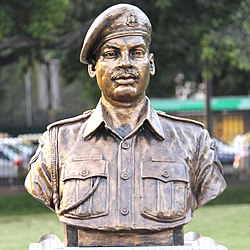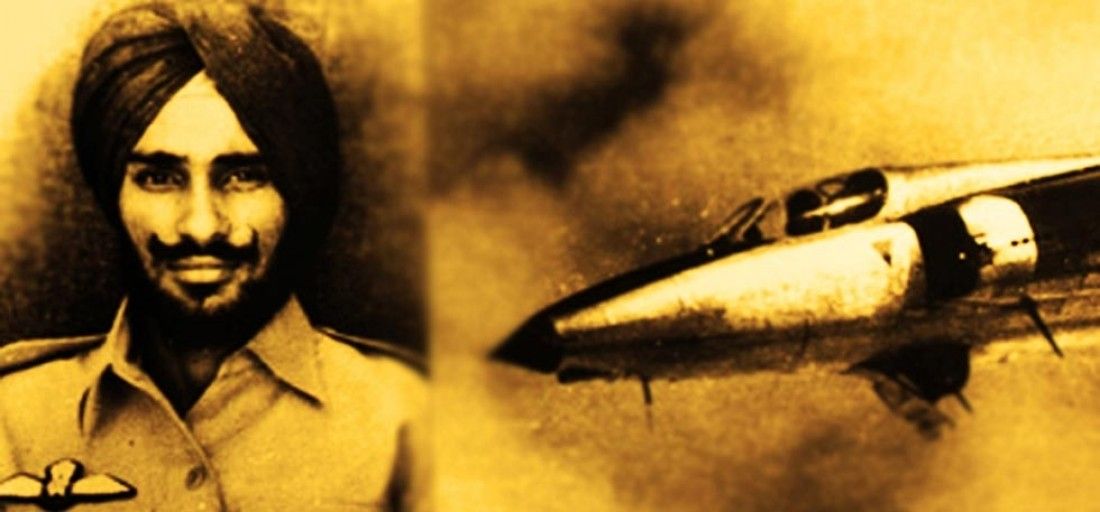On Monday, Prime Minister Narendra Modi gave the names of India’s 21 Param Vir Chakra winners to the 21 largest unnamed islands in the Andaman and Nicobar Islands. On Parakram Diwas, which is the anniversary of Netaji Subhas Chandra Bose’s birth, the ceremony was held.
In a press release, the Prime Minister’s Office said, “The Prime Minister has always given the highest priority to honouring the real-life heroes of the country. In this spirit, it has been decided to name the 21 largest islands in the island group after the 21 people who have won the Param Vir Chakra.
Ross Island used to be called Netaji Subhash Chandra Bose Dweep. When the Prime Minister visited the island in 2018, he changed the name to Ross Island. Shaheed Dweep and Swaraj Dweep were also given to Neil Island and Havelock Island.
Also read: The Delhi Police’s advice on routes to avoid and other routes for Republic Day 2023
Major Somnath Sharma: On November 3, 1947, in the Battle of Badgam, Major Sharma was in charge of the single company of the 4th Battalion, Kumaon Regiment. They were trying to defend the Srinagar airport from Pakistani raiders, who were much more numerous than the Indian troops at the post. Sharma, a junior officer, and 20 other people died, along with Sharma. He was the first person to ever get the PVC.
Karam Singh was a Subedar and Honorary Captain (at the time, he was a Lance Naik). On October 13, 1948, during the first Indo-Pakistani war, Singh stopped the Pakistani army from taking over the Tithwal sector in Jammu and Kashmir. Even though he was hurt by the heavy shelling from the Pakistan side, he stayed on the ground and fought bravely. He also freed two Indian soldiers who were being held captive.
Second Lieutenant Rama Raghoba Rane: He was very important in helping Indian forces take over Rajouri, Jammu and Kashmir, on April 8, 1948, while the Pakistan Army was shelling the area. Rane ducked under India’s Stuart tank and started crawling with it. The website said, “He synchronised himself with the dangerous tank wheels and guided the tank through the minefield by guiding it with a rope tied to the tank driver, clearing a path for the Indian tanks to follow.”
Naik Jadunath Singh: On February 6, 1948, Singh, who was a post commander at Tain Dhar near Naushera in Jammu and Kashmir, and his post were attacked by the Pakistani military. Even though he was badly hurt and had lost several of his men, he used a Sten Gun to attack the enemy and drive them away. Singh, however, died in the battle and was only given the PVC after he died.
Company Havildar Major Piru Singh: of a group that was sent to Tithwal in Jammu and Kashmir to take a Pakistani post. On July 18, 1948, Singh died while carrying out the mission. Records show that Singh and other Indian troops were attacked with grenades and medium machine gun (MMG) fire during the mission. Even though all of his other soldiers died, the Company Havildar Major was still able to destroy “the enemy position” before he died.
Captain GS Salary: Successfully defended the UN Headquarters at Elizabethville (now called Lubumbashi) in the Democratic Republic of the Congo. On December 5, 1961, his Gorkha Company was supposed to get rid of a roadblock set up by Katangese troops, but they ran into a lot of trouble from the enemy. Salaria and his men fought bravely and killed about 40 of the enemy soldiers, making the rest run away. The Captain’s neck was hurt very badly, and he died soon after.
Lieutenant Colonel (then Major) Dhan Singh Thapa: During the Sino-Indian War, on October 20, 1962, the Chinese troops attacked Thapa and his men in Ladakh, where he was in charge of a forward post. The Chinese troops were far more numerous than Thapa and his men. The first two times the Chinese tried to take over the Indian forces, they failed. It wasn’t until the third time, when they charged with tanks, that they were able to take the post. The National War Memorial’s website said, “Major Dhan Singh Thapa killed several enemy soldiers in hand-to-hand combat before he was finally defeated.”
Subedar Joginder Singh: He died on October 23, 1962, when the Chinese military attacked his post in Bumla, Arunachal Pradesh. Singh, who was in charge of that platoon, didn’t leave even though most of his men were killed. He stayed where he was. On the website for the National War Memorial, it says, “Subedar Joginder himself used a light machine gun (LMG) to kill a number of enemy troops.”
Major Shaitan Singh: He fought bravely against the Chinese attack on November 18, 1962, when he was in charge of his platoon at Rezang La in Jammu and Kashmir. Rezang La is about 17,000 feet high. Singh was badly hurt, but he kept moving from platoon post to platoon post, encouraging his men and helping them fight the enemy. Singh wouldn’t leave when he was told to, and he fought until the end.
What a befitting tribute and so appropriate.🇮🇳🇮🇳🇮🇳 On the occasion of the 126th birth anniversary of Netaji Subhas Chandra Bose, Honorable Prime Minister Narendra Modi will name 21 islands of Andaman and Nicobar after 21 Param Vir Chakra awardees.@narendramodi #armedforcesofIndia pic.twitter.com/rt5YS5t7CU
— Ranganathan Madhavan (@ActorMadhavan) January 23, 2023
Company Quartermaster Havildar Abdul Hamid : Best known for leading a jeep-mounted RCL Gun Detachment during the Indo-Pak war of 1965 and destroying two of Pakistan’s tanks. Even when the enemy saw Hamid’s jeep, he didn’t stop attacking them. He helped his detachment destroy seven more Pakistani tanks before he was killed.
Lieutenant Colonel Ardeshir Burzorji Tarapore: On September 11, 1965, an attack happened in the Sialkot Sector, where Lieutenant Colonel Tarapore’s Regiment was. But his regiment stood its ground and attacked Phillora with courage. Even though Lieutenant Colonel Tarapore was hurt, he refused to be taken away. Instead, he stayed with his Regiment and led them to capture Wazirwali, Jassoran, and Butur-Dograndi. Because of how he led, his team was able to destroy 60 Pakistani tanks.
Lance Naik Albert Ekka: During the battle of Gangasagar on December 4, 1971, Lance Naik Ekka saw an enemy LMG killing a lot of people in his company. He charged the enemy bunker without caring about his own safety, bayoneted two enemy soldiers, and stopped the LMG. Out of nowhere, another MMG came out of a building. Even though he was dying, he crawled forward and threw a grenade at a soldier, killing him. Lance Naik Ekka finally stopped the MMG when he went into the building and beat the gunner with his bare hands.

Major Hoshiar Singh: On December 15, 1971, the enemy village of Jarpal was to be taken by Major Hoshiar Singh’s company. During the attack, his company was shelled very hard. He led the charge anyway, and after a fierce hand-to-hand fight, he took the objective. Even though he was badly hurt, he was able to get his troops to fight off wave after wave of enemy attacks. He even manned a machine gun post all by himself after enemy fire killed its operators. His bravery and skill as a leader helped the Indian Army keep control of the goal and win the war in the end.
Second Lt. Arun Khetarpal: On December 16, 1971, Second Lieutenant Arun Khetarpal moved on his own to help the “B” Squadron in the Shakargarh sector of Punjab because they needed help right away. On the way to B Squadron, his tanks were hit hard by enemy strong points, which he had to destroy to get to B Squadron. After that, there was a fierce tank battle in which Khetarpal took out four of the ten enemy tanks. Even though he was badly hurt, he didn’t stop fighting. He shot down one more enemy tank before dying from a second enemy shell.
Flying Officer Nirmal Jit Singh Sekhon: Two Pakistani Sabre planes bombed Srinagar airfield on December 14, 1971. Flying Officer Nirmal Jit Singh Sekhon took off in his Gnat fighter, which was much weaker than the Pakistani Sabres at low altitude, from the damaged runway and attacked the enemy. He did this even though he was putting his own life in danger. He shot down one plane and did a lot of damage to another. At this point, four more Sabre planes from Pakistan had arrived. Flying Officer Sekhon’s plane was shot down by the many more enemy planes, killing him. He is the only Indian Air Force member who has ever won the PVC.

Major Ramaswamy Parameswaran: On November 25, 1987, Major Ramaswamy Parameswaran’s team was ambushed as they were coming back from a search mission in Sri Lanka. Having a clear head, he quickly organised his troops and got around the militants. When the militant shot Major Parameswaran in the chest, he grabbed his gun and killed him. Even though he was badly hurt, he kept giving orders and motivating his troops until he died. His action not only saved his team, but also helped kill five militants and find a large stash of weapons and ammunition.
Naib Subedar Bana Singh: On June 26, 1987, Naib Subedar Bana Singh volunteered for a task force to clear Quaid Post, which was held by the Pak Army in the Siachen Glacier at a height of 21,000 feet. The biggest threat to survival in Siachen was the harsh weather, which included strong blizzards, temperatures of almost -50 degrees Celsius, and a lack of oxygen. Naib Subedar Singh and his team charged Pakistani positions, killing the enemy with grenades and bayonets. They did this by climbing a 457-m-high ice wall when they couldn’t see anything.
Captain Vikram Batra: On July 7, 1999, a feature was to be taken at Point 4875 in Ladakh by his company. He killed five enemy soldiers in a fierce hand-to-hand battle. Even though he was badly hurt, he led his men from the front while under heavy fire from the enemy. He died as a martyr. Because of what he did, his troops killed all of the enemy and took Point 4875. The phrase “Yeh Dil Maange More” by Captain Batra has become a lasting symbol of the bravery of the Indian Army.
Lt. Manoj Kumar Pandey: On July 3, 1999, the enemy fired heavily on his company. His PVC says that he attacked the enemy without fear, killing four of them and destroying two bunkers. Even though he was bleeding a lot, he kept leading his men to clear bunker after bunker, often fighting with the enemy in hand-to-hand combat. He gave up his life for his country by making sure that his men were able to reach their goal.
Subedar Major (then Rifleman) Sanjay Kumar: On July 4, 1999, Rifleman Kumar charged at the enemy who was shooting at his team from well-protected positions. He didn’t care about his own safety at all. During the next fight, he was badly hurt but still managed to kill three enemy soldiers before attacking the next position. His unexpected attack made the enemy run away, which let the Indian Army take over Flat Top point, which had been held by the enemy.
Yogesh Singh Yadav, Subedar Major and Honorable Captain Retired: On July 2 and 3, 1999, the enemy was camped in strongpoints on top of Tiger Hill and fired heavily at his team. Yadav crawled up to the enemy position to try to silence them. He killed four enemy soldiers in close combat, even though he was badly hurt himself. Because of his bravery, the rest of his team was able to take the Tiger Hill Top, which was a major goal for the Indian Army.




